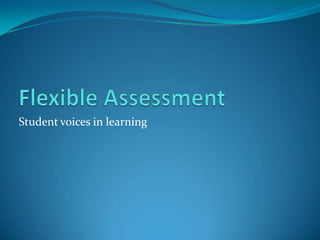
Flexible Assessment
- 1. Student voices in learning
- 2. Student Choices Students choose weight of assessments Students self-assess Students peer assess Students choose how to assess Students choose what to assess !
- 3. Student Choices Students choose weight of assessments – ‘Plussage’ Plussage’ is a novel system of combining formative and summative assessment. For example, students complete two assessments (mid- and end-semester exams). Both assessments are considered to be summative, but the student gets to choose whether the first assessment counts in the final grade. If it does, it counts for 25% of the final grade while the second assessment counts for 75%. If the student chooses to discount the first grade, then the second assessment is counted for 100% of the grade. This allows the first assessment item to be either a low summative or a formative assessment. There is real incentive to study for and achieve well in such a first assessment. Plussage allows early indication of poor understanding with potentially no final grade consequence for a student. In addition, the high stakes anxiety can be removed from the final grade if the student performs well in the first assessment. Plussage also provides a useful tool for tutors, moderators and students to assess the effectiveness of this early assessment and subsequent feedback on learning. - Special thanks to Craig Hilton, M.D., for bringing this work on plussage to our attention
- 4. Student Choices Students self-assess Reflection- on-Action Discussion Study
- 5. Student Choices Students peer assess Student learn their own strengths and weaknesses by grading each other, enhancing their own learning Peer assessment improves subsequent work and enhances student understanding Students learn how to assess and how to test better
- 6. Student Choices Students choose how to assess Assessment Oral report? Written One report? Assessment Presentation? Video? Two Assessment Multiple Essay? Three Choice?
- 7. Student Choices Students choose what to assess Formative 2 Item 3 Item 1 Item 6 Summative Portfolio Formative 1 Formative 3
- 8. Flexible Assessment Flexible Flexible Learning teachers Superior Graduates
Notes de l'éditeur
- Flexible assessment is about students participating in their own learning. It’s about learners making informed choices on the manner and form of their performance that demonstrates how well they have learned, and how well they can apply that learning in a variety of contexts. Flexible assessment is about giving students the assessment options that they believe will demonstrate their learning in the best light possible.
- [N]: Flexible assessment gives learners choices in how their performance will be evaluated. Whether they participate in determining how much a particular assessment will be weighted in their overall course grade, whether they assess themselves or their peers, or whether they get to choose how to be assessed or what specific work will count as assessment material, learners begin to take responsibility for their learning and development.
- See the text of the slide.
- In self-assessment, students engage with the curriculum through study, through discussion, through action, and all throughout they reflect on what they are learning and how they are learning. At the end of their study they present an overview of their learning experiences by performing Reflection-on-Action. [click on the lightning bolt under ‘Reflection-on-Action’ above to activate an online video] on reflection.]
- See the text of the slide
- When students choose how to assess, they have the opportunity, within the parameters of the learning outcomes, to perform in a way that suits their learning style. Students from a predominantly oral culture, for example, may prefer to give an oral report for assessment, while those who are more comfortable with the written word will chose to write their assessment. Those who are comfortable in front of an audience may prefer to present, while others may prefer the safety of a pre-recorded video presentation. In all this, if the form of the assessment allows students to meet the learning outcomes, then students are satisfying the requirements of the curriculum.Oral or written reportsLive action or video reportsVariety on the job
- When students choose what to assess, they can choose the work that best represents the skill and knowledge sets that they have developed from their study. For example, from a series of formative assessments, students can choose which one will become the summative assessment for their grade. Another option is a portfolio of work to be graded, where students can choose from amongst a body of work those items which best represents their learning.
- We are tasked with helping students become life-long learning, self-managing professionals. Flexibility in our facilitation, in our assessments, and in ourselves, all leading students to prepare, participate and perform to the high standards of our curriculum, is a sure way to help our students become the professionals they want to be.